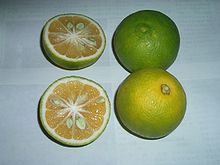Kabosu
| Kabosu | |
|---|---|

| |
| Scientific classification | |
| Kingdom: | |
| (unranked): | |
| (unranked): | |
| (unranked): | |
| Order: | |
| Family: | |
| Genus: | |
| Species: | C. sphaerocarpa
|
| Binomial name | |
| Citrus sphaerocarpa | |
Kabosu (カボス or 臭橙) is a juicy green citrus fruit closely related to the yuzu with the sharpness of lemon, used instead of vinegar in some Japanese dishes. It grows on a flowering plant with sharp thorns, and the fruit is harvested when still green but ripens to yellow. Thought to be an ichang papeda - bitter orange hybrid, the Kabosu was brought over from China in the Edo Period and became a popular fruit in Japan. It is produced in most areas of Ōita Prefecture but particularly in Taketa and Usuki. The actual fruit is regarded as a delicacy in other parts of Japan, as it is often expensive outside of Ōita Prefecture. It improves the taste of many dishes, especially baked fish, sashimi and hot pot dishes.
References
